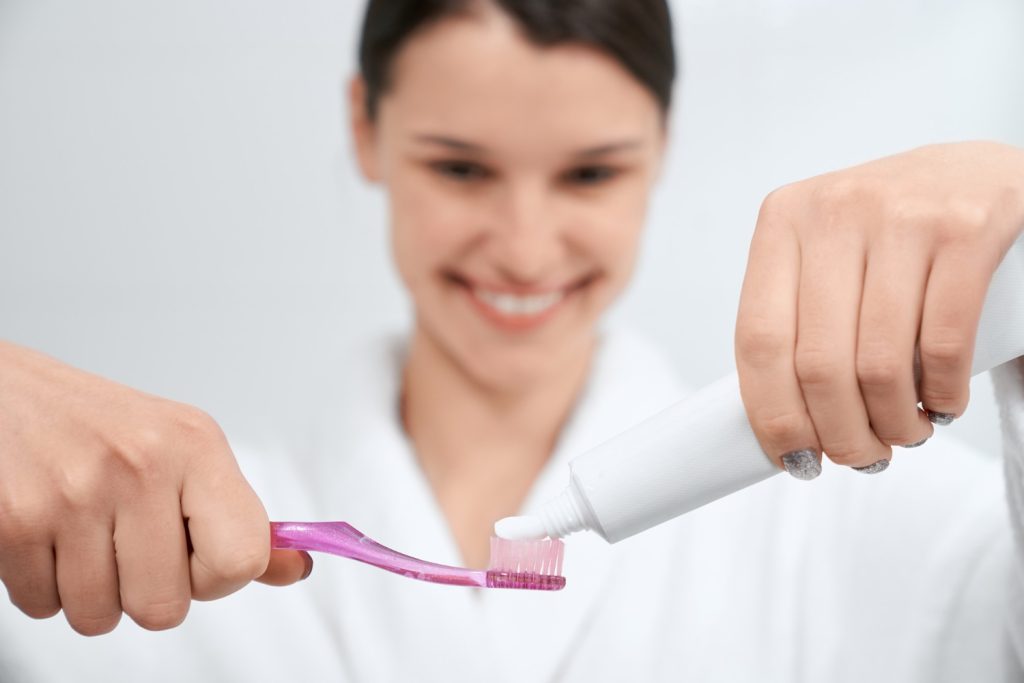You brush twice a day, floss regularly, and use mouthwash – so why does your dentist still find issues during checkups? The answer might lie in those 30 seconds right after you brush.
Picture this: You’ve just finished your nightly brushing routine. Your teeth feel squeaky clean, and that minty-fresh sensation fills your mouth. Naturally, you reach for a cup of water, swish vigorously, and spit. It’s automatic, right? We’ve all been doing it since childhood.
But here’s the plot twist that might make you rethink your entire routine: rinsing immediately after brushing could be undoing much of the good work you just did.
What’s Really Happening in Your Mouth
When I first heard about the “no-rinse rule” from my dental hygienist, I thought she was pulling my leg. Don’t rinse after brushing? That seemed counterintuitive – almost gross, honestly. But the science behind it is actually pretty fascinating.
Most toothpastes contain fluoride, a mineral that’s been a game-changer in oral care since the 1950s. When you brush, you’re not just scrubbing away plaque and food particles; you’re also coating your teeth with this protective mineral. Think of fluoride as a microscopic shield that helps strengthen tooth enamel throughout the night or day.
But here’s where it gets interesting: fluoride needs time to work its magic. When you immediately rinse with water after brushing, you’re essentially washing away this protective coating before it has a chance to do its job. It’s like applying sunscreen and then jumping in the pool right away – you’re not giving it time to absorb and provide protection.
The optimal approach, according to multiple studies, is surprisingly simple: brush, spit out the excess toothpaste foam, and then… just walk away. No water, no mouthwash, no additional rinsing for at least 30 minutes.
I know what you’re thinking – “But what about that weird taste?” or “Doesn’t that feel gross?” Trust me, I had the same concerns. The reality is that after spitting out the excess, there’s really not much toothpaste left in your mouth. You might notice a slight minty aftertaste for a few minutes, but it’s not overwhelming.
Real Talk: Making the Switch (And Why It’s Harder Than It Sounds)
Changing a habit you’ve been doing for decades isn’t exactly a walk in the park. When I first tried the no-rinse method, I caught myself reaching for the water cup at least five times that first week. It’s like trying to break any other automatic behavior – your brain is on autopilot.
Here’s what helped me make the transition smoother:
Start with just one brushing session. Instead of going cold turkey, I began with my nighttime routine only. Since I was heading to bed anyway, the lingering minty taste wasn’t as noticeable.
Use less toothpaste. Most of us squeeze out way more than we need (thanks, toothpaste commercials with those perfect ribbon swirls). A pea-sized amount is actually plenty, and using less means there’s less to spit out and less aftertaste.
Time your routine differently. I moved my evening brushing to about 30 minutes before bed instead of right before hitting the pillow. This gave the fluoride time to work while I did other bedtime activities like reading or light stretching.
The Global Perspective: What Other Countries Have Been Doing Right
Interestingly, the no-rinse approach isn’t revolutionary everywhere. In many European countries, dental guidelines have recommended this method for years. The UK’s National Health Service has been advocating for minimal rinsing since the early 2000s.
Sweden, which has some of the lowest rates of tooth decay globally, has long promoted fluoride retention techniques. Their dental education emphasizes the importance of allowing fluoride to remain on teeth after brushing.
It makes you wonder – have we been overthinking oral care in some ways while missing simple, effective strategies in others?
Addressing the Elephant in the Room: What About Mouthwash?
This is probably the question I get asked most when I share this information with friends: “What about my mouthwash routine?”
Here’s the thing about mouthwash timing – it’s all about strategy. If you’re someone who loves that extra-clean feeling from mouthwash (and I totally get that), consider using it at a different time of day. Maybe after lunch, or 30 minutes after your morning brush.
Some people prefer to use mouthwash before brushing, which actually isn’t a bad approach. It can help loosen debris and bacteria, making your brushing more effective. Then you finish with the fluoride toothpaste and avoid rinsing.
The key is not to let mouthwash immediately wash away the fluoride you just applied through brushing.
Special Considerations: When the Rules Might Be Different
Like most health and wellness advice, the no-rinse rule isn’t necessarily one-size-fits-all. Some people have specific oral health situations that might require different approaches.
If you’re using prescription-strength fluoride toothpaste, your dental professional might have specific instructions about rinsing or not rinsing. Always follow their guidance over general recommendations.
People with certain medical conditions or those taking specific medications might also need customized oral care routines. Dry mouth, for instance, can change how fluoride interacts with your teeth and saliva.
The Bigger Picture: Rethinking Our Relationship with Oral Care
This whole rinse-or-don’t-rinse discussion really got me thinking about how we approach oral care in general. We live in a culture that often equates “more” with “better” – more scrubbing, more rinsing, more products. But sometimes, the most effective approach is actually more subtle.
Traditional wisdom in many cultures emphasized gentle, consistent care over aggressive cleaning. Maybe there’s something to be learned from that perspective.
The no-rinse method is just one example of how small changes in our daily routines can potentially have meaningful impacts over time. It’s not about dramatic overhauls or expensive products – it’s about understanding the science behind what we’re already doing and optimizing it slightly.
Making It Work in Real Life: Practical Tips from Someone Who’s Been There
After six months of following the no-rinse approach, here are the strategies that made the biggest difference for me:
Keep your toothbrush routine exactly the same. Don’t change your brushing technique, the amount of time you spend, or your toothpaste. The only difference is what happens after you spit.
Have a distraction ready. In those first few weeks, I’d immediately start another small task after brushing – checking my phone, organizing my bedside table, or doing some light stretches. It kept my mind off the urge to rinse.
Travel considerations. When traveling, especially in areas where water quality might be a concern, the no-rinse method actually becomes more appealing. You’re not introducing potentially questionable water into your mouth right after cleaning.
The Long Game: What to Expect Over Time
I wish I could tell you that I noticed dramatic changes overnight, but that’s not how oral care works. The benefits of better fluoride retention are cumulative and subtle.
What I did notice after a few months was that my teeth felt smoother throughout the day. That rough, filmy feeling that sometimes develops between brushings seemed less pronounced. My dental hygienist also mentioned that my fluoride uptake appeared improved during my next cleaning, though she acknowledged that multiple factors could contribute to that.
The most significant change, honestly, was psychological. Breaking an automatic habit and replacing it with a more intentional approach made me more mindful of my entire oral care routine. I started paying attention to other aspects of my dental health that I’d been doing on autopilot.
Beyond Brushing: The Bigger Oral Health Picture
While we’re talking about optimizing post-brushing habits, it’s worth mentioning that oral care is really a holistic practice. The no-rinse approach is just one piece of a larger puzzle.
Diet plays a huge role in oral health – and not just avoiding obvious culprits like candy and soda. The timing of when you eat and drink can matter as much as what you consume. Acidic foods and beverages can temporarily soften tooth enamel, which is why some dental professionals recommend waiting at least an hour after eating before brushing.
Stress management also connects to oral health in ways many people don’t realize. Stress can contribute to teeth grinding, jaw clenching, and even changes in saliva production. It’s all connected.
Sleep quality affects everything, including your mouth’s ability to repair and maintain itself overnight. This is another reason why optimizing your nighttime oral care routine – including the no-rinse approach – might be particularly beneficial.
The Environmental Angle: An Unexpected Bonus
Here’s something I didn’t expect when I started skipping the post-brush rinse: it’s actually more environmentally friendly. Those 30 seconds of running water after brushing might seem insignificant, but they add up. The average person uses about 2-3 gallons of water during a typical brushing session when you factor in wetting the brush, rinsing the mouth, and cleaning the sink.
By eliminating just the mouth-rinsing portion, you’re reducing water usage without sacrificing cleanliness. It’s a small change that aligns with other sustainable living practices many of us are trying to adopt.
Addressing Common Concerns and Myths
Over the months I’ve been following this approach, I’ve heard every concern and myth imaginable. Let me address the most common ones:
“Isn’t it unsanitary to leave toothpaste residue in your mouth?” Actually, fluoride toothpaste is designed to be safe if small amounts remain after spitting. The ingredients are carefully formulated with this in mind.
“What if I accidentally swallow some?” The amount of toothpaste that might remain after proper spitting is minimal. Swallowing tiny amounts occasionally isn’t a concern for most people.
“My mouth feels weird without rinsing.” This is totally normal and usually resolves within a week or two as you adjust to the new routine. Using less toothpaste can help minimize this sensation.
“Does this work with all types of toothpaste?” The no-rinse approach is most beneficial with fluoride toothpastes, which includes most standard brands. If you’re using specialized toothpastes, check with your dental professional about the best approach.
Cultural Shifts in Oral Care: A Historical Perspective
It’s interesting to consider how oral care recommendations have evolved over time. Fifty years ago, brushing once a day was considered adequate by many. The concept of flossing wasn’t widely promoted until the 1970s.
Electric toothbrushes were once considered unnecessary gadgets, and now many dental professionals prefer them for certain patients. Mouthwash was primarily seen as a breath freshener rather than a health tool.
The no-rinse recommendation represents another evolution in our understanding of oral care science. It’s a reminder that even well-established routines can benefit from occasional reevaluation based on new research and understanding.
Building Sustainable Habits: The Psychology of Change
What I found most challenging about adopting the no-rinse approach wasn’t the physical aspect – it was overriding decades of ingrained behavior. This experience taught me a lot about habit formation and change.
The key wasn’t willpower; it was creating new neural pathways through consistent repetition. Every time I successfully completed my brushing routine without rinsing, I was strengthening a new habit pattern.
Having a clear understanding of why I was making the change helped maintain motivation during those first few weeks when the old behavior felt more natural.
Practical Implementation: A Step-by-Step Transition
If you’re curious about trying the no-rinse approach, here’s a gentle transition plan that worked well for me:
Week 1-2: Try it just for your nighttime routine. Brush, spit, and go straight to your next bedtime activity.
Week 3-4: Add your morning routine, but give yourself 30 minutes before eating or drinking anything.
Week 5-6: Fine-tune your technique. Experiment with using slightly less toothpaste or adjusting your spitting technique to remove more excess without rinsing.
Month 2 and beyond: Evaluate how the new routine feels and whether you notice any changes in how your mouth feels throughout the day.
The Social Aspect: Talking to Family and Friends
One unexpected challenge was explaining this new habit to family members, especially when traveling or staying with others. The questioning looks when I walked away from the sink without rinsing were pretty amusing.
I found that sharing the science behind it helped. Most people were curious rather than skeptical once they understood the reasoning. Some family members even decided to try it themselves.
For parents, this might be an interesting discussion point with children, though it’s worth consulting with a pediatric dental professional about the best approach for kids.
Looking Forward: The Future of Oral Care
The no-rinse discussion is part of a broader trend toward evidence-based oral care practices. As research continues to evolve, we’re likely to see more refinements in how we approach daily dental hygiene.
Personalized oral care – routines tailored to individual risk factors, genetics, and lifestyle – is becoming more sophisticated. What works best for one person might not be optimal for another.
Technology is also playing a role, with smart toothbrushes that can track brushing patterns and apps that help optimize timing and technique.
But sometimes, the most impactful changes are the simplest ones – like reconsidering whether we really need to rinse after brushing.
Final Thoughts: Small Changes, Potential Big Impact
After nearly a year of following the no-rinse approach, I can honestly say it’s become as natural as the old habit ever was. My teeth feel clean, my routine is actually slightly faster, and I have peace of mind knowing I’m giving fluoride the best chance to do its job.
The experience taught me something valuable about being open to changing long-held habits when presented with good evidence. It’s easy to dismiss new information when it contradicts what we’ve always done, but sometimes those challenges to conventional wisdom are worth considering.
Whether you decide to try the no-rinse approach or stick with your current routine, the most important thing is maintaining consistent, gentle oral care practices that work for your lifestyle and needs.
Your mouth does so much for you every day – speaking, eating, smiling, expressing emotions. Taking a few extra minutes to optimize how you care for it seems like a pretty good investment.
And who knows? This small change might inspire you to look at other daily habits with fresh eyes. Sometimes the path to better health isn’t about adding more to our routines – it’s about refining what we’re already doing.

Thanks for reading — from all of us at First News US. The information in this article is for educational purposes only and is not intended as medical or dental advice. Always consult with qualified healthcare professionals for personalized guidance regarding your oral health needs. Individual results may vary, and this content should not be considered a substitute for professional dental care or consultation.
Sources and references for the information presented in this article include peer-reviewed dental research, guidelines from recognized dental organizations, and published studies on fluoride retention and oral care practices. Readers are encouraged to discuss any changes to their oral care routine with their dental healthcare provider.



